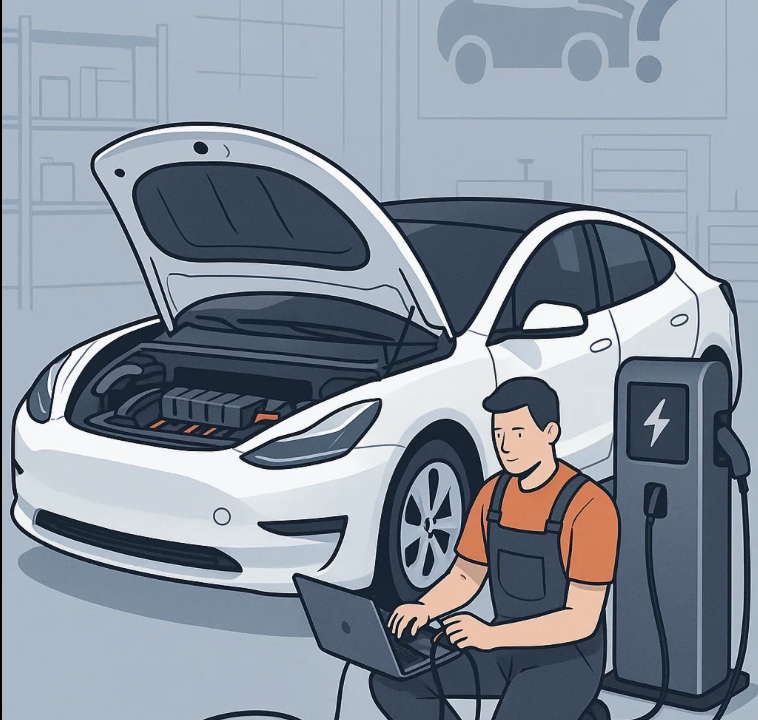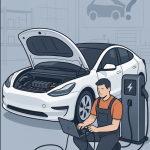
Introduction
Electric vehicles (EVs) are praised for their quiet ride, instant torque, and lower running costs. But what happens when they break down? While EVs have fewer moving parts than traditional cars, the reality of repairing them is far more complex than many buyers realize.
From battery diagnostics to software issues and scarce spare parts, the repair landscape for EVs presents unique challenges. In this article, we break down what to expect when your electric car needs more than just a tire rotation.
1. Fewer Moving Parts – But Higher Complexity
It’s often said that EVs have “less to go wrong.” This is true—no oil changes, no timing belts, no exhaust systems. But what many forget is:
🔌 EVs replace mechanical systems with electronics and software.
🧠 That means diagnosing problems often requires proprietary tools, manufacturer-specific training, and access to secure digital systems.
🔒 Many EVs are now “locked” behind diagnostic firewalls, making independent repair harder or impossible without manufacturer cooperation.
2. Batteries: The Elephant in the Garage
The battery is by far the most expensive and sensitive component in any electric vehicle.
Key Facts:
-
💰 Battery replacements can cost €8,000 to €20,000, depending on model and capacity.
-
🔋 Battery degradation is real – especially in early or lower-quality cells.
-
⚠️ Some manufacturers don’t offer full battery replacement, only module-level service – if at all.
Also problematic:
-
Cell imbalance or BMS (Battery Management System) faults can disable the car entirely.
-
A minor physical damage to the battery (e.g., from road debris) often triggers automatic shutdown, requiring dealer-level diagnostics.
3. Who Can Fix It? Fewer Repair Options Than You Think
Unlike traditional cars, EVs can’t be fixed by just any mechanic.
Challenges:
-
🔧 Special certification is required to legally work on high-voltage systems.
-
👨🔧 In 2025, less than 30% of EU auto shops are certified to work on EV drivetrains (source: EUREKA AutoTech Survey, 2024).
-
🛠️ Dealerships are often overwhelmed or limit repairs to warranty cases only.
This leaves many EV owners stranded with:
-
Weeks-long wait times
-
Limited service coverage in rural areas
-
Unclear costs due to diagnostic delays
4. Software Issues – The New Check Engine Light
Modern EVs are rolling computers. Over-the-air updates, complex driver-assistance systems, and app integration create new failure points.
Common software-related problems:
-
❌ OTA updates causing compatibility errors
-
❌ Driver assist systems (ADAS) failing calibration after windshield replacement
-
❌ Charging system bugs or communication failures with public stations
Often, these issues require factory tools to fix, meaning you’re at the mercy of the brand’s service center availability.
5. Insurance & Accidents: Totals Are More Common
Even low-speed collisions can lead to high repair costs if:
-
The battery casing is damaged
-
Sensors (LIDAR, radar, cameras) are affected
-
Structural parts made of aluminum or composites are involved
Insurance companies are increasingly writing off EVs after minor damage due to high replacement part prices and repair complexity.
According to AXA (2024 report), EVs are 30% more likely to be declared a total loss after a crash than comparable ICE vehicles.
6. What Can You Do as an Owner?
Here’s how to stay ahead of potential EV repair issues:
✅ Before You Buy:
-
Research battery warranty terms (length, mileage, and what’s covered)
-
Ask about local repair options and certified workshops
-
Check if battery replacements are modular or full-unit only
-
Verify software support policies (how long will your EV receive updates?)
✅ After You Own:
-
Schedule regular system checks (especially post-warranty)
-
Monitor battery health via the app or OBD tools
-
Keep your software up to date, but be cautious with early releases
-
Consider extended warranty or third-party EV coverage
Final Thoughts
Electric vehicles are the future—but that future isn’t without complications. Repairs can be more expensive, slower, and harder to access than many owners expect.
If you’re considering buying—or already own—an EV, it’s worth understanding not just the driving experience, but also the reality of maintenance and repair. A little research today can save you weeks (and thousands) down the road.
Related Articles:















